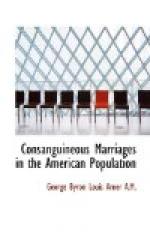[Footnote 6: See Transactions of the American Medical Association, 1858, pp. 321-425.]
[Footnote 7: “Du Croisement des families,” Mem. de la Societe d’Anthropologie, vol. i, 1860-63, pp. 505-557.]
[Footnote 8: See Morris: “On Marriages of Consanguinity,” in Amer. Med. Times, Mar. 23, 1861.]
[Footnote 9: See Bulletins de la Societe d’Anthropologie, 1863, pp. 515-575; 1877, pp. 203-213.]
In England similar discussions took place during the same period, complicated, however, by the presence of the patient and long-suffering “deceased wife’s sister.” The best of the English work has been the statistical study by George H. Darwin,[10] and the classic “Marriage of Near Kin” by Alfred H. Huth, a book of 475 pages, including a very complete bibliography to the date of the second edition, 1885. Although Mr. Huth’s book is not free from error, and is encumbered with a large amount of worthless material, it is now after thirty-three years, by far the best treatment of the subject.
[Footnote 10: “Marriages of First Cousins in England and their Effects,” Journal Statistical Society, 1875, pp. 153-184.]
In Italy Dr. Montegazza,[11] in Spain Senor Pastor[12] and others, have made useful contributions. German writers have usually preferred more general subjects, but many of them have given much space to consanguineous marriage in sociological and biological works.
[Footnote 11: Studj Sui Matrimonj Consanguinei. Quoted by Darwin, op. cit., p. 178.]
[Footnote 12: “De los Matrimonios entre Parientes,” Memorias de la Real Academia de Ciencias Morales y Politicas, vol. ii, pp. 369-400.]
Since the appearance of the Bemiss report little has been published in this country which bears directly upon our subject. The most important American contribution, however, is to be found in the Special Report on the Blind and the Deaf, in the Twelfth Census of the United States, prepared by Dr. Alexander Graham Bell. Although American writers have had little part in the theoretical discussions, our legislators have been active, so that the statutes of every state specify degrees of kinship within which marriage is




